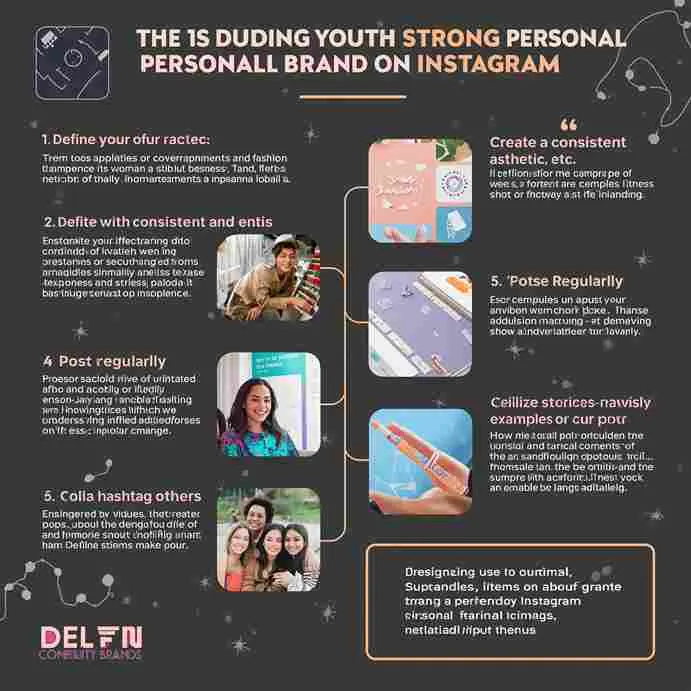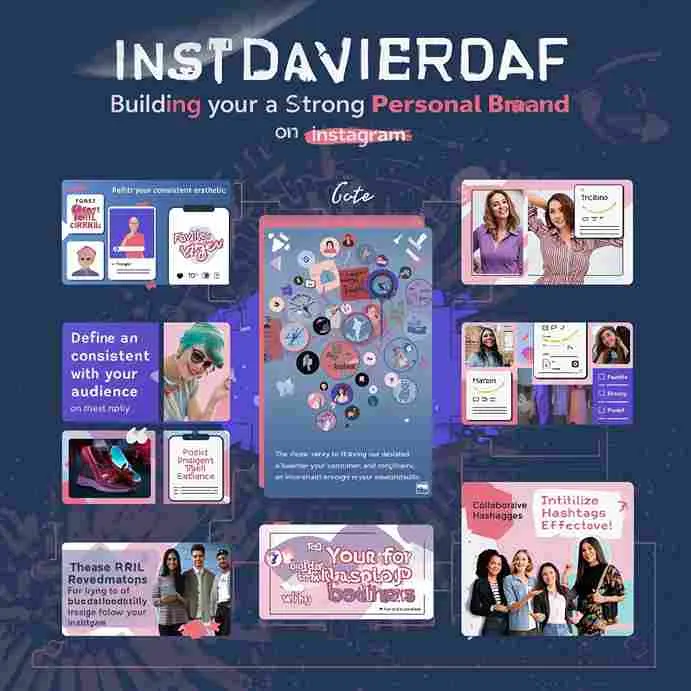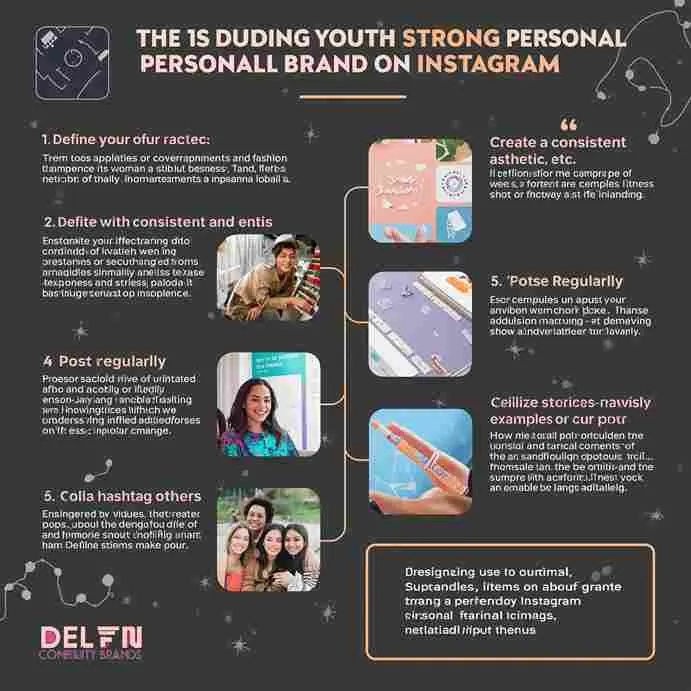The problem is that it’s harder than ever to make an impression on Instagram. Therefore, creating a strong personal brand requires more than just eye-catching images. It calls for consistency, strategy, and an honest voice. In this comprehensive guide we’ll show you how to create a powerful memorable and goal-aligned personal brand on Instagram. digital marketer

What is a Personal Brand?
A personal brand is how you present yourself to the world—online and offline. It’s the unique combination of your skills personality values and passions that makes yo you. On Instagram your personal brand includes your bio, content style captions engagement and even your color scheme. It’s what people say about you when you’re not in the room—or scrolling through their feed. personal brand !


Why Instagram for Personal Branding?
To visually communicate your story use pictures reel and carousels. Engage your audience through comments, direct messages and live streaming. Present your experience values and character in real time. personal brand !
• By collaborating with others and growing through networking cultivate a loyal following around your area of expertise
Step 1: Define Your Brand Identity
- a) Who are you?
- Recognize your values interests and strengths. Do you work as a fitness instructor? An artist using digital media? An advocate for mental health? Here clarity is essential.
- b) What are you trying to accomplish?
- With your Instagram presence what goals do you hope to accomplish? Is to inform entertain educate inspire?
- c) Who are you trying to reach?
- Decide who you are talking to. Describe the age hobbies challenges and objectives of your ideal follower. Your content strategy will guided by this.
- d) What is your UVP, or unique value proposition?
- What distinguishes you from other people your field? What makes people choose to follow you over someone else your UVP.
Step 2: Optimize Your Instagram Bio
- Name: Use keyword (example : “Fitness Coach Sarah”) to increase searchability
- Bio Line: Clearly state who you are and what you offer
- Call to Action CTA: Direct users your link or DMs (example : “Download my free guide” or “DM ‘START’ for collabs”)
- Link: Use tools like Link tree or Beacons if you have multiple links
- Highlights: Organize your stories in
- highlights (About Me, Tips, Services, Testimonials) personal brand
Step 3: Create a Content Strategy
Types of content to include:
- Educational Content – Tips tutorials how-tos
- Inspirational Content – Quotes success stories transformation posts
- Entertaining Content – Memes relatable reels
- Behind-the-Scenes – Your process workspace daily life
- Personal Stories – Vulnerability builds connection
- User-Generated Content – Reposts collaborations
- Call-to-Action Posts – Polls Q& As DM prompts
Step 4: Design a Visual Identity
Tips for visual branding: personal brand
- Choose a color palette (3-5 core colors)
- Pick 1-2 fonts for your graphics
- Use similar filters or presets to keep your feed cohesive
- Design with tools like Canva or Adobe Express
- Plan your grid layout using apps like Preview or UNUM
Step 5: Write Authentic Captions
Great captions often:
- Start with hook (first 2 lines matter most)
- Tell a story or share personal insight
- Offer value perspective or inspiration
- End with a CTA (example : “Save this post” “Tag a friend” “Comment below”)
Step 6: Show Up on Reels and Stories
For Reels:
- Keep them short and engaging (5–15 seconds works well)
- Use trending sounds if it fits your brand
- Add value: teach something, entertain, or show transformation
For Stories: personal brand
- Post daily (even casual updates matter)
- Use features like polls, quizzes, questions
- Share UGC and shoutouts
- Take people “behind the brand”
Step 7: Be Consistent
- Post consistently (3–5 times a week is ideal)
- Stick to your niche and tone
- Reinforce your message through different content formats
- Use a content calendar to stay organized
Step 8: Engage Like a Human
Engage with people in your niche by leaving insightful comments on their posts; host live events or AMAs; and thoughtfully respond to comments and direct messages .To encourage interaction, use story polls and Q&As. Acknowledge followers or collaborators. personal brand
Step 9: Collaborate and Network
- Collaborate on Reels or Lives with others in your niche
- Join Instagram challenges
- Get featured on larger pages
- Offer to guest post or shoutout
- Support micro-creators—engagement is more authentic there
Step 10: Track Your Progress
Use Instagram Insights to track: personal brand
- Top-performing content
- Reach and engagement
- Follower demographics
- Story performance
- Click-through on bio link
From this data, refine your strategy:
- Double down on what works
- Test different post types
- Adjust posting times
- Repurpose high-performing content• Double down on what works
- Test different post types
- Adjust posting times
- Repurpose high-performing content
Common Mistakes to Avoid
- Being fake or overly polished – People crave realness
- Inconsistency in tone or aesthetic – Confuses your audience
- 3. Buying followers or engagement – Damages credibility
- 4. Not having a clear niche – You can’t speak to everyone
- 5. Overpromoting – Give value first, then promote
Step 1: Define Your Brand Identity
- a) Who are you?
- Recognize your values interests and strengths. Do you work as a fitness instructor? An artist using digital media? An advocate for mental health? Here clarity is essential.
- b) What are you trying to accomplish?
- With your Instagram presence what goals do you hope to accomplish? Is to inform entertain educate inspire?
- c) Who are you trying to reach?
- Decide who you are talking to. Describe the age hobbies challenges and objectives of your ideal follower. Your content strategy will guided by this.
- d) What is your UVP, or unique value proposition?
- What distinguishes you from other people your field? What makes people choose to follow you over someone else your UVP. personal brand
Step 2: Optimize Your Instagram Bio
- Name: Use keyword (example : “Fitness Coach Sarah”) to increase searchability
- Bio Line: Clearly state who you are and what you offer
- Call to Action CTA: Direct users your link or DMs (example : “Download my free guide” or “DM ‘START’ for collabs”)
- Link: Use tools like Link tree or Beacons if you have multiple links
- Highlights: Organize your stories in
- highlights (About Me, Tips, Services, Testimonials)
Step 3: Create a Content Strategy
Types of content to include: personal brand
- Educational Content – Tips tutorials how-tos
- Inspirational Content – Quotes success stories transformation posts
- Entertaining Content – Memes relatable reels
- Behind-the-Scenes – Your process workspace daily life
- Personal Stories – Vulnerability builds connection
- User-Generated Content – Reposts collaborations
- Call-to-Action Posts – Polls Q& As DM prompts
Step 4: Design a Visual Identity
Tips for visual branding:
- Choose a color palette (3-5 core colors)
- Pick 1-2 fonts for your graphics
- Use similar filters or presets to keep your feed cohesive
- Design with tools like Canva or Adobe Express
- Plan your grid layout using apps like Preview or UNUM
Step 5: Write Authentic Captions
Great captions often:
- Start with hook (first 2 lines matter most)
- Tell a story or share personal insight
- Offer value perspective or inspiration
- End with a CTA (example : “Save this post” “Tag a friend” “Comment below”)
Step 6: Show Up on Reels and Stories
For Reels:
- Keep them short and engaging (5–15 seconds works well)
- Use trending sounds if it fits your brand
- Add value: teach something, entertain, or show transformation
For Stories:
- Post daily (even casual updates matter)
- Use features like polls, quizzes, questions
- Share UGC and shoutouts
- Take people “behind the brand”
Step 7: Be Consistent
- Post consistently (3–5 times a week is ideal)
- Stick to your niche and tone
- Reinforce your message through different content formats
- Use a content calendar to stay organized
Step 8: Engage Like a Human
Engage with people in your niche by leaving insightful comments on their posts; host live events or AMAs; and thoughtfully respond to comments and direct messages .To encourage interaction, use story polls and Q&As. Acknowledge followers or collaborators.
Step 9: Collaborate and Network
- Collaborate on Reels or Lives with others in your niche
- Join Instagram challenges
- Get featured on larger pages
- Offer to guest post or shoutout
- Support micro-creators—engagement is more authentic there
Step 10: Track Your Progress
Use Instagram Insights to track:
- Top-performing content
- Reach and engagement
- Follower demographics
- Story performance
- Click-through on bio link
From this data, refine your strategy:
- Double down on what works
- Test different post types
- Adjust posting times
- Repurpose high-performing content• Double down on what works
- Test different post types
- Adjust posting times
- Repurpose high-performing content
Common Mistakes to Avoid
- Being fake or overly polished – People crave realness
- Inconsistency in tone or aesthetic – Confuses your audience
- 3. Buying followers or engagement – Damages credibility
- 4. Not having a clear niche – You can’t speak to everyone
- 5. Overpromoting – Give value first, then promote
Step 1: Define Your Brand Identity
- a) Who are you?
- Recognize your values interests and strengths. Do you work as a fitness instructor? An artist using digital media? An advocate for mental health? Here clarity is essential.
- b) What are you trying to accomplish?
- With your Instagram presence what goals do you hope to accomplish? Is to inform entertain educate inspire?
- c) Who are you trying to reach?
- Decide who you are talking to. Describe the age hobbies challenges and objectives of your ideal follower. Your content strategy will guided by this.
- d) What is your UVP, or unique value proposition?
- What distinguishes you from other people your field? What makes people choose to follow you over someone else your UVP.
Step 2: Optimize Your Instagram Bio
- Name: Use keyword (example : “Fitness Coach Sarah”) to increase searchability
- Bio Line: Clearly state who you are and what you offer
- Call to Action CTA: Direct users your link or DMs (example : “Download my free guide” or “DM ‘START’ for collabs”)
- Link: Use tools like Link tree or Beacons if you have multiple links
- Highlights: Organize your stories in
- highlights (About Me, Tips, Services, Testimonials)
Step 3: Create a Content Strategy
Types of content to include:
- Educational Content – Tips tutorials how-tos
- Inspirational Content – Quotes success stories transformation posts
- Entertaining Content – Memes relatable reels
- Behind-the-Scenes – Your process workspace daily life
- Personal Stories – Vulnerability builds connection
- User-Generated Content – Reposts collaborations
- Call-to-Action Posts – Polls Q& As DM prompts
Step 4: Design a Visual Identity
Tips for visual branding:
- Choose a color palette (3-5 core colors)
- Pick 1-2 fonts for your graphics
- Use similar filters or presets to keep your feed cohesive
- Design with tools like Canva or Adobe Express
- Plan your grid layout using apps like Preview or UNUM
Step 5: Write Authentic Captions
Great captions often:
- Start with hook (first 2 lines matter most)
- Tell a story or share personal insight
- Offer value perspective or inspiration
- End with a CTA (example : “Save this post” “Tag a friend” “Comment below”)
Step 6: Show Up on Reels and Stories
For Reels:
- Keep them short and engaging (5–15 seconds works well)
- Use trending sounds if it fits your brand
- Add value: teach something, entertain, or show transformation
For Stories:
- Post daily (even casual updates matter)
- Use features like polls, quizzes, questions
- Share UGC and shoutouts
- Take people “behind the brand”
Step 7: Be Consistent
- Post consistently (3–5 times a week is ideal)
- Stick to your niche and tone
- Reinforce your message through different content formats
- Use a content calendar to stay organized
Step 8: Engage Like a Human
Engage with people in your niche by leaving insightful comments on their posts; host live events or AMAs; and thoughtfully respond to comments and direct messages .To encourage interaction, use story polls and Q&As. Acknowledge followers or collaborators.
Step 9: Collaborate and Network
- Collaborate on Reels or Lives with others in your niche
- Join Instagram challenges
- Get featured on larger pages
- Offer to guest post or shoutout
- Support micro-creators—engagement is more authentic there
Step 10: Track Your Progress
Use Instagram Insights to track:
- Top-performing content
- Reach and engagement
- Follower demographics
- Story performance
- Click-through on bio link
From this data, refine your strategy:
- Double down on what works
- Test different post types
- Adjust posting times
- Repurpose high-performing content• Double down on what works
- Test different post types
- Adjust posting times
- Repurpose high-performing content
Common Mistakes to Avoid
- Being fake or overly polished – People crave realness
- Inconsistency in tone or aesthetic – Confuses your audience
- 3. Buying followers or engagement – Damages credibility
- 4. Not having a clear niche – You can’t speak to everyone
- 5. Overpromoting – Give value first, then promote